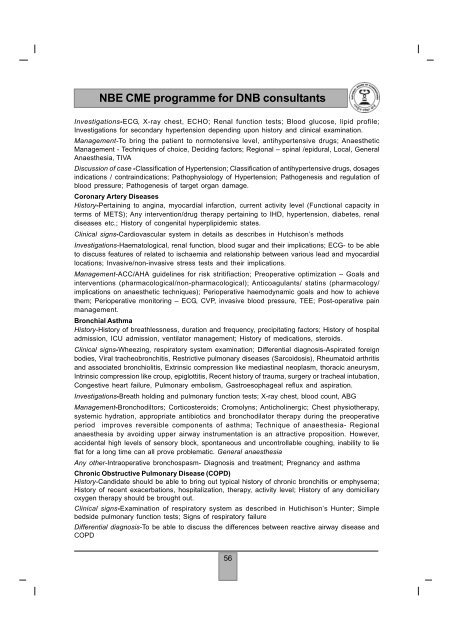<strong>NBE</strong> <strong>CME</strong> <strong>programme</strong> <strong>for</strong> <strong>DNB</strong> <strong>consultants</strong>Investigations-ECG, X-ray chest, ECHO; Renal function tests; Blood glucose, lipid profile;Investigations <strong>for</strong> secondary hypertension depending upon history and clinical examination.Management-To bring the patient to normotensive level, antihypertensive drugs; AnaestheticManagement - Techniques of choice, Deciding factors; Regional – spinal /epidural, Local, GeneralAnaesthesia, TIVADiscussion of case -Classification of Hypertension; Classification of antihypertensive drugs, dosagesindications / contraindications; Pathophysiology of Hypertension; Pathogenesis and regulation ofblood pressure; Pathogenesis of target organ damage.Coronary Artery DiseasesHistory-Pertaining to angina, myocardial infarction, current activity level (Functional capacity interms of METS); Any intervention/drug therapy pertaining to IHD, hypertension, diabetes, renaldiseases etc.; History of congenital hyperplipidemic states.Clinical signs-Cardiovascular system in details as describes in Hutchison’s methodsInvestigations-Haematological, renal function, blood sugar and their implications; ECG- to be ableto discuss features of related to ischaemia and relationship between various lead and myocardiallocations; Invasive/non-invasive stress tests and their implications.Management-ACC/AHA guidelines <strong>for</strong> risk stritifiaction; Preoperative optimization – Goals andinterventions (pharmacological/non-pharmacological); Anticoagulants/ statins (pharmacology/implications on anaesthetic techniques); Perioperative haemodynamic goals and how to achievethem; Perioperative monitoring – ECG, CVP, invasive blood pressure, TEE; Post-operative painmanagement.Bronchial AsthmaHistory-History of breathlessness, duration and frequency, precipitating factors; History of hospitaladmission, ICU admission, ventilator management; History of medications, steroids.Clinical signs-Wheezing, respiratory system examination; Differential diagnosis-Aspirated <strong>for</strong>eignbodies, Viral tracheobronchitis, Restrictive pulmonary diseases (Sarcoidosis), Rheumatoid arthritisand associated bronchiolitis, Extrinsic compression like mediastinal neoplasm, thoracic aneurysm,Intrinsic compression like croup, epiglottitis, Recent history of trauma, surgery or tracheal intubation,Congestive heart failure, Pulmonary embolism, Gastroesophageal reflux and aspiration.Investigations-Breath holding and pulmonary function tests; X-ray chest, blood count, ABGManagement-Bronchodiltors; Corticosteroids; Cromolyns; Anticholinergic; Chest physiotherapy,systemic hydration, appropriate antibiotics and bronchodilator therapy during the preoperativeperiod improves reversible components of asthma; Technique of anaesthesia- Regionalanaesthesia by avoiding upper airway instrumentation is an attractive proposition. However,accidental high levels of sensory block, spontaneous and uncontrollable coughing, inability to lieflat <strong>for</strong> a long time can all prove problematic. General anaesthesiaAny other-Intraoperative bronchospasm- Diagnosis and treatment; Pregnancy and asthmaChronic Obstructive Pulmonary Disease (COPD)History-Candidate should be able to bring out typical history of chronic bronchitis or emphysema;History of recent exacerbations, hospitalization, therapy, activity level; History of any domiciliaryoxygen therapy should be brought out.Clinical signs-Examination of respiratory system as described in Hutichison’s Hunter; Simplebedside pulmonary function tests; Signs of respiratory failureDifferential diagnosis-To be able to discuss the differences between reactive airway disease andCOPD56
<strong>NBE</strong> <strong>CME</strong> <strong>programme</strong> <strong>for</strong> <strong>DNB</strong> <strong>consultants</strong>Investigations-Should be able to discuss, Chest x-ray, Pulmonary function tests, flow volume loops,arterial blood gases, and their implicationsManagement-Preoperative risk stratification and optimization of the patient <strong>for</strong> lung surgery andother non-thoracic surgery; To be able to discuss lung isolation and implications of one lunganaesthesia; Modalities of post-operative pain management available and their implicationsDiabetes MellitusHistory-Type, duration of DM, involvement of other organs, treatment history; Ischaemic heartdisease, work up, latest recommendation of drugs; History to evaluate end organ damageClinical signs- Evaluate vitals and signs of organ involvement; Autonomic, peripheral neuropathyInvestigations-Haemoglobin and relevance; Glycosylated haemoglobin and its relevance; ECG, X-ray chest; Blood chemistryManagement-Drugs used <strong>for</strong> glycemic control; Drugs used <strong>for</strong> other co-morbid situations;Anaesthetic implications including perioperative control of blood sugar; Diabetes coming <strong>for</strong>emergency surgery; Management of diabetic coma; Glycemic control in critically ill patientsThyroid Swelling with hyper & hypo functionHistory-Residence— endemic areas; Swelling—onset, duration, whether associated with pain,any sudden increase in size with pain; Sleep disturbance-like complaints of sleeplessness as inprimary thyrotoxicosis; Pain, Pressure Effects- dyspnoea, dysphagia, hoarseness of voice, stridor;Symptoms of Primary Thyrotoxicosis-loss of weight, preference <strong>for</strong> cold and intolerance to heatand excessive sweating; CNS involvement - nervous excitability, irritability, insomnia, tremor ofhands and weakness of muscles; Cardiovascular Symptoms-palpitation, tachycardia.and dyspnoeaon exertion; Exophthalmos-staring or protruding eyes, double vision or diplopia, any edema orswelling of the conjunctiva (chemosis); Menstrual disturbances-usually amenorrhoea; Symptomsof Secondary Thyrotoxicosis— more of cardiovascular system; involvement-palpitations, irregularheart beats (ectopics), dyspnoea on exertion, chest pain, signs of CCF like ankle swelling, oliguria;Symptoms of myxoedema (Hypothyroidism) -increase of weight in spite of poor appetite, intoleranceof cold weather, dryness of skin, facial puffiness, dull expression, loss of hair, muscle fatigue andlethargy, failing memory and hoarseness of voice; Constipation; Oligomenorrhoea; Past history—Course of treatment and its effect on the swelling; H/O ingestion of goitrogenic drug eg.. PAS orsulphonylureas or antithyroid drugs, which are goitrogenic ; Personal History - Dietary habits,Goitrogenic Vegetables—; Family History - H/O similar occurrences in family, endemic goiter.Clinical signs and symptoms-Build and state of Nutrition; Facies, Mental state and Intelligence;Pulse Rate- rate, rhythm, regularity, Sleeping Pulse Rate ; Skin — hot and moist or dry and inelastic;Tremor; Local Examination- Inspection, palpation, percussion, auscultation; General Examination;Primary toxic manifestations in case of goiters affecting the young ; Secondary toxic manifestationsin nodular goiter; Metastasis in case of malignant thyroid disease; Search <strong>for</strong> Metastasis- - Cervicalnodes; Distant metastasis-bones such as skull, spine, end of long bones etc.; Lung metastasisDifferential diagnosis-Non-toxic goiter-Diffuse parenchymatous, Colloid, Multinodular, Solitarynodular; Toxic goiter-Diffuse (Grave’s Disease), Multinodular, Toxic nodule (solitary nodular) ;Neoplastic —Benign or Malignant; Thyroiditis -Acute bacterial, Granulomatous, Autoimmune,Riedel,s, ; Chronic bacterial; Retrostemal goiter -knowledge of the diagnostic features.Investigations and Management- Thyroid Function Tests; Serum Protein Bound Iodine; SerumThyroxine (T4) ; Total SerumTri-iodothyronine (T3) ; T3 Resin Uptake Test; Serum Thyroid StimulatingHonnone (TSH); T3 Suppression Test; Thyroid Scan; Miscellaneous Test-BMR, Serum Creatinine,Serum cholesterol, Measurement of tendon reflexes, ECG; Radiography-to diagnose position oftrachea; Both AP and Lateral view of neck; Bone Scan; FNAC; UltrasoundManagement-Medical Management; Surgical Management- Anaesthetic management includingperioperative complication57
















